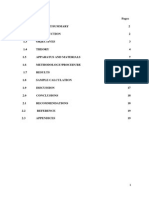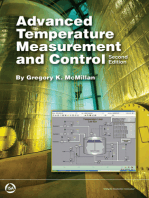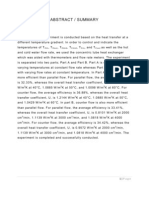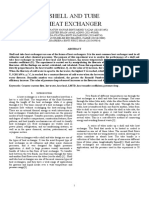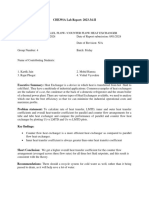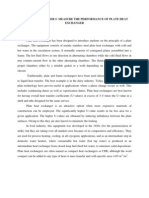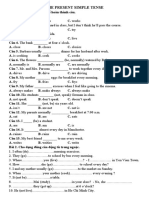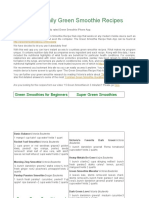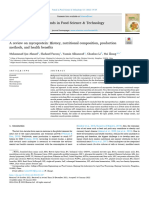Unit Operations in Food Processing - R. L (Nomor 1) PDF
Unit Operations in Food Processing - R. L (Nomor 1) PDF
Uploaded by
Wahyu ApriliyantoCopyright:
Available Formats
Unit Operations in Food Processing - R. L (Nomor 1) PDF
Unit Operations in Food Processing - R. L (Nomor 1) PDF
Uploaded by
Wahyu ApriliyantoOriginal Title
Copyright
Available Formats
Share this document
Did you find this document useful?
Is this content inappropriate?
Copyright:
Available Formats
Unit Operations in Food Processing - R. L (Nomor 1) PDF
Unit Operations in Food Processing - R. L (Nomor 1) PDF
Uploaded by
Wahyu ApriliyantoCopyright:
Available Formats
Unit Operations in Food Processing - R. L. Earle http://www.nzifst.org.nz/unitoperations/httrapps1.
htm
UNIT OPERATIONS IN FOOD PROCESSING
Contents > Heat-Transfer Applications > Introduction, Heat Exchangers this page
CHAPTER 6
Home HEAT TRANSFER APPLICATIONS
Contents
About the book
Heat exchangers
Introduction
Continuous-flow Heat Exchangers
Material and energy Jacketed Pans
balances Heating Coils Immersed in Liquids
Fluid-flow theory Scraped Surface Heat Exchangers
Plate Heat Exchangers
Fluid-flow applications
Heat-transfer theory
Heat-transfer The principles of heat transfer are widely used in food processing in many items
applications of equipment. It seems appropriate to discuss these under the various
Drying applications that are commonly encountered in nearly every food factory.
Evaporation
Contact-equilibrium
HEAT EXCHANGERS
separation processes
Mechanical In a heat exchanger, heat energy is transferred from one body or fluid stream to
separations another. In the design of heat exchange equipment, heat transfer equations are
applied to calculate this transfer of energy so as to carry it out efficiently and
Size reduction
under controlled conditions. The equipment goes under many names, such as
Mixing boilers, pasteurizers, jacketed pans, freezers, air heaters, cookers, ovens and so
Appendices on. The range is too great to list completely. Heat exchangers are found widely
Index to Figures scattered throughout the food process industry.
Index to Examples
References
Bibliography
Useful links
Feedback (email link)
Continuous-flow Heat Exchangers
It is very often convenient to use heat exchangers in which one or both of the materials that are exchanging heat
are fluids, flowing continuously through the equipment and acquiring or giving up heat in passing.
One of the fluids is usually passed through pipes or tubes, and the other fluid stream is passed round or across
these. At any point in the equipment, the local temperature differences and the heat transfer coefficients control
the rate of heat exchange.
The fluids can flow in the same direction through the equipment, this is called parallel flow; they can flow in
opposite directions, called counter flow; they can flow at right angles to each other, called cross flow. Various
combinations of these directions of flow can occur in different parts of the exchanger. Most actual heat
exchangers of this type have a mixed flow pattern, but it is often possible to treat them from the point of view of
the predominant flow pattern. Examples of these exchangers are illustrated in Figure 6.1.
1 dari 7 12/10/2015 14:42
Unit Operations in Food Processing - R. L. Earle http://www.nzifst.org.nz/unitoperations/httrapps1.htm
Figure 6.1 Heat exchangers
In parallel flow, at the entry to the heat exchanger, there is the maximum temperature difference between the
coldest and the hottest stream, but at the exit the two streams can only approach each other's temperature. In a
counter flow exchanger, leaving streams can approach the temperatures of the entering stream of the other
component and so counter flow exchangers are often preferred.
Applying the basic overall heat-transfer equation for the the heat exchanger heat transfer:
q = UA DT
uncertainty at once arises as to the value to be chosen for DT, even knowing the temperatures in the entering
and leaving streams.
Consider a heat exchanger in which one fluid is effectively at a constant temperature, Tb as illustrated in Fig.
6.1(d). Constant temperature in one component can result either from a very high flow rate of this component
compared with the other component, or from the component being a vapour such as steam or ammonia
condensing at a high rate, or from a boiling liquid. The heat-transfer coefficients are assumed to be independent
of temperature.
The rate of mass flow of the fluid that is changing temperature is G kg s-1, its specific heat is cp J kg-1 °C-1. Over
a small length of path of area dA, the mean temperature of the fluid is T and the temperature drop is dT. The
constant temperature fluid has a temperature Tb. The overall heat transfer coefficient is U J m-2 s-1 °C-1.
Therefore the heat balance over the short length is:
cpGdT = U(T - Tb)dA
Therefore U/)cpG) dA = dT/(T –Tb)
If this is integrated over the length of the tube in which the area changes from A = 0 to A = A, and T changes
from T1 to T2, we have:
U/(cpG) A = ln[(T1 – Tb)/(T2 - Tb)] (where ln = loge)
= ln (DT1/ DT2)
in which DT1 = (T1 – Tb) and DT2 = (T2 - Tb)
2 dari 7 12/10/2015 14:42
Unit Operations in Food Processing - R. L. Earle http://www.nzifst.org.nz/unitoperations/httrapps1.htm
therefore cpG = UA/ ln (DT1/ DT2)
From the overall equation, the total heat transferred per unit time is given by
q = UADTm
where DTm is the mean temperature difference, but the total heat transferred per unit is also:
q = cpG(T1 –T2)
so q = UADTm = cpG(T1 –T2) = UA/ ln (DT1/ DT2)] x (T1 –T2)
but (T1 –T2) can be written (T1 – Tb) - (T2 - Tb)
so (T1 –T2) = (DT1 - DT2)
therefore UADTm = UA(DT1 - DT2) / ln (DT1/ DT2) (6.1)
so that
DTm = (DT1 - DT2) / ln (DT1/ DT2) (6.2)
where DTm is called the log mean temperature difference.
In other words, the rate of heat transfer can be calculated using the heat transfer coefficient, the total area, and
the log mean temperature difference. This same result can be shown to hold for parallel flow and counter flow
heat exchangers in which both fluids change their temperatures.
The analysis of cross-flow heat exchangers is not so simple, but for these also the use of the log mean
temperature difference gives a good approximation to the actual conditions if one stream does not change very
much in temperature.
EXAMPLE 6.1. Cooling of milk in a pipe heat exchanger
Milk is flowing into a pipe cooler and passes through a tube of 2.5 cm internal diameter at a rate of 0.4 kg s-1. Its
initial temperature is 49°C and it is wished to cool it to 18°C using a stirred bath of constant 10°C water round the
pipe. What length of pipe would be required? Assume an overall coefficient of heat transfer from the bath to the
milk of 900 J m-2 s-1 °C-1, and that the specific heat of milk is 3890 J kg-1 °C-1.
Now
q = cpG (T1 –T2)
= 3890 x 0.4 x (49 - 18)
= 48,240 J s-1
Also q = UADTm
DTm = [(49 - 10) - (18 –10)] / ln[(49 -10)1(18 - 10)]
= 19.6°C.
Therefore 48,240 = 900 x A x l9.6
A = 2.73 m2
but A = pDL
where L is the length of pipe of diameter D
Now D = 0.025 m.
L = 2.73/(p x 0.025)
= 34.8 m
This can be extended to the situation where there are two fluids flowing, one the cooled fluid and the other the
heated fluid. Working from the mass flow rates (kg s-1) and the specific heats of the two fluids, the terminal
temperatures can normally be calculated and these can then be used to determine DTm and so, from the
heat-transfer coefficients, the necessary heat-transfer surface.
3 dari 7 12/10/2015 14:42
Unit Operations in Food Processing - R. L. Earle http://www.nzifst.org.nz/unitoperations/httrapps1.htm
EXAMPLE 6.2. Water chilling in a counter flow heat exchanger
In a counter flow heat exchanger, water is being chilled by a sodium chloride brine. If the rate of flow of the brine
is 1.8 kg s-1 and that of the water is 1.05 kg s-1, estimate the temperature to which the water is cooled if the brine
enters at -8°C and leaves at 10°C, and if the water enters the exchanger at 32°C. If the area of the heat-transfer
surface of this exchanger is 55 m2, what is the overall heat-transfer coefficient? Take the specific heats to be
3.38 and 4.18 kJ kg-1 °C-1 for the brine and the water respectively.
With heat exchangers a small sketch is often helpful:
Figure 6.2. Diagrammatic heat exchanger
Figure 6.2 shows three temperatures are known and the fourth Tw2 (= T''2 say on Fig 6.2) can be found from the
heat balance:
By heat balance, heat loss in brine = heat gain in water
1.8 x 3.38 x [10 - (-8)] = 1.05 x 4.18 x (32 - Tw2)
Therefore Tw2 = 7°C.
And for counterflow
DT1 = [32 - 10] = 22°C and DT2 = [7 - (-8)] = 15°C.
Therefore DTm = (22 - 15)/ln(22/15)
= 7/0.382
= 18.3°C.
For the heat exchanger
q = heat exchanged between fluids = heat lost by brine = heat gain to water
= heat passed across heat transfer surface
= UADTm
Therefore
3.38 x 1.8 x 18 = U x 55 x 18.3
U = 0.11 kJ m-2 °C-1
= 110 J m-2 °C-1
Parallel flow situations can be worked out similarly, making appropriate adjustments.
In some cases, heat-exchanger problems cannot be solved so easily; for example, if the heat transfer
coefficients have to be calculated from the basic equations of heat transfer which depend on flow rates and
temperatures of the fluids, and the temperatures themselves depend on the heat-transfer coefficients. The
easiest way to proceed then is to make sensible estimates and to go through the calculations. If the final results
are coherent, then the estimates were reasonable. If not, then make better estimates, on the basis of the results,
and go through a new set of calculations; and if necessary repeat again until consistent results are obtained. For
those with multiple heat exchangers to design, computer programmes are available.
Jacketed Pans
In a jacketed pan, the liquid to be heated is contained in a vessel, which may also be provided with an agitator to
keep the liquid on the move across the heat-transfer surface, as shown in Fig. 6.3(a).
4 dari 7 12/10/2015 14:42
Unit Operations in Food Processing - R. L. Earle http://www.nzifst.org.nz/unitoperations/httrapps1.htm
Figure 6.3. Heat exchange equipment
The source of heat is commonly steam condensing in the vessel jacket. Practical considerations of importance
are:
1. There is the minimum of air with the steam in the jacket.
2. The steam is not superheated as part of the surface must then be used as a de-superheater over which low
gas heat-transfer coefficients apply rather than high condensing coefficients.
3. Steam trapping to remove condensate and air is adequate.
The action of the agitator and its ability to keep the fluid moved across the heat transfer surface are important.
Some overall heat transfer coefficients are shown in Table 6.1. Save for boiling water, which agitates itself,
mechanical agitation is assumed. Where there is no agitation, coefficients may be halved.
TABLE 6.1
SOME OVERALL HEAT TRANSFER COEFFICIENTS IN JACKETED PANS
Condensing fluid Heated fluid Pan material Heat transfer coefficients
J m-2 s-1 °C-1
Steam Thin liquid Cast-iron 1800
Steam Thick liquid Cast-iron 900
Steam Paste Stainless steel 300
Steam Water, boiling Copper 1800
EXAMPLE 6.3. Steam required to heat pea soup in jacketed pan
Estimate the steam requirement as you start to heat 50 kg of pea soup in a jacketed pan, if the initial temperature
of the soup is 18°C and the steam used is at 100 kPa gauge. The pan has a heating surface of 1 m2 and the
overall heat transfer coefficient is assumed to be 300 J m-2 s-1 °C-1.
From steam tables (Appendix 8), saturation temperature of steam at 100 kPa gauge = 120°C and latent heat = l
5 dari 7 12/10/2015 14:42
Unit Operations in Food Processing - R. L. Earle http://www.nzifst.org.nz/unitoperations/httrapps1.htm
= 2202 kJ kg-1.
q = UA DT
= 300 x 1 x (120 - 18)
= 3.06 x 104 J s-1
Therefore amount of steam
= q/l = (3.06 x 104)/(2.202 x 106)
= 1.4 x 10-2 kg s-1
= 1.4 x 10-2 x 3.6 x 103
= 50 kg h-1.
This result applies only to the beginning of heating; as the temperature rises less steam will be consumed as DT
decreases.
The overall heating process can be considered by using the analysis that led up to eqn. (5.6). A stirred vessel to
which heat enters from a heating surface with a surface heat transfer coefficient which controls the heat flow,
follows the same heating or cooling path as does a solid body of high internal heat conductivity with a defined
surface heating area and surface heat transfer coefficient.
EXAMPLE 6.4. Time to heat pea soup in a jacketed pan
In the heating of the pan in Example 6.3, estimate the time needed to bring the stirred pea soup up to a
temperature of 90°C, assuming the specific heat is 3.95 kJ kg-1 °C-1.
From eqn. (5.6) (T2 - Ta)/(T1– Ta) = exp(-hsAt/crV )
Ta = 120°C (temperature of heating medium)
T1 = 18°C (initial soup temperature)
T2 = 90°C (soup temperature at end of time t)
hs = 300 J m-2 s-1 °C-1
A = 1 m2, c = 3.95 kJ kg-1 °C-1.
rV = 50 kg
Therefore t = -3.95 x 103 x 50 x ln (90 - 120) / (18 - 120)
300 x 1
= (-658) x (-1.22) s
= 803 s
= 13.4 min.
Heating Coils Immersed in Liquids
In some food processes, quick heating is required in the pan, for example, in the boiling of jam. In this case, a
helical coil may be fitted inside the pan and steam admitted to the coil as shown in Fig. 6.3(b). This can give
greater heat transfer rates than jacketed pans, because there can be a greater heat transfer surface and also the
heat transfer coefficients are higher for coils than for the pan walls. Examples of the overall heat transfer
coefficient U are quoted as:
300-1400 for sugar and molasses solutions heated with steam using a copper coil,
1800 for milk in a coil heated with water outside,
3600 for a boiling aqueous solution heated with steam in the coil.
with the units in these coefficients being J m-2 s-1 °C-1.
Scraped Surface Heat Exchangers
One type of heat exchanger, that finds considerable use in the food processing industry particularly for products
of higher viscosity, consists of a jacketed cylinder with an internal cylinder concentric to the first and fitted with
scraper blades, as illustrated in Fig. 6.3(c). The blades rotate, causing the fluid to flow through the annular space
between the cylinders with the outer heat transfer surface constantly scraped. Coefficients of heat transfer vary
with speeds of rotation but they are of the order of 900-4000 J m-2 s-1 °C-1. These machines are used in the
freezing of ice cream and in the cooling of fats during margarine manufacture.
6 dari 7 12/10/2015 14:42
Unit Operations in Food Processing - R. L. Earle http://www.nzifst.org.nz/unitoperations/httrapps1.htm
Plate Heat Exchangers
A popular heat exchanger for fluids of low viscosity, such as milk, is the plate heat exchanger, where heating and
cooling fluids flow through alternate tortuous passages between vertical plates as illustrated in Fig. 6.3(d). The
plates are clamped together, separated by spacing gaskets, and the heating and cooling fluids are arranged so
that they flow between alternate plates. Suitable gaskets and channels control the flow and allow parallel or
counter current flow in any desired number of passes. A substantial advantage of this type of heat exchanger is
that it offers a large transfer surface that is readily accessible for cleaning. The banks of plates are arranged so
that they may be taken apart easily. Overall heat transfer coefficients are of the order of 2400-6000 J m-2 s-1 °C-1.
Heat-Transfer Applications > THERMAL PROCESSING
Back to the top
Unit Operations in Food Processing. Copyright © 1983, R. L. Earle. :: Published by NZIFST (Inc.)
7 dari 7 12/10/2015 14:42
You might also like
- Tubular Heat Exchanger Lab ReportDocument21 pagesTubular Heat Exchanger Lab ReportMuhammad Zafrulhafiz80% (5)
- Experiment of Shell & Tube Heat ExchangerDocument29 pagesExperiment of Shell & Tube Heat ExchangerNanaNaurah9578% (9)
- Heat ExchangerDocument21 pagesHeat ExchangersedamyrulNo ratings yet
- Advanced Temperature Measurement and Control, Second EditionFrom EverandAdvanced Temperature Measurement and Control, Second EditionNo ratings yet
- Young Dark Emu - Teachers - NotesDocument15 pagesYoung Dark Emu - Teachers - NotesPixie TaylorNo ratings yet
- Concentric Tube Heat ExchangerDocument19 pagesConcentric Tube Heat ExchangerBen Widdowson100% (2)
- Heat Exchanger Lab Report - Reference MaterialDocument30 pagesHeat Exchanger Lab Report - Reference MaterialFarwa RizviNo ratings yet
- LAB SOLAHshell&TubeHeatExchangerDocument28 pagesLAB SOLAHshell&TubeHeatExchangerSo Lah MusaNo ratings yet
- Che310 2Document27 pagesChe310 2Enendu BlessingNo ratings yet
- Heat ExchangerDocument11 pagesHeat ExchangerSyafiyatulMunawarahNo ratings yet
- Heat ExchangerDocument39 pagesHeat ExchangerRamanipriya MAHALINGAMNo ratings yet
- Analysis of Heat Transfer Coefficient of Shell and Tube On Heat Exchanger Using Heat Transfer Research Inch (HTRI) SoftwareDocument10 pagesAnalysis of Heat Transfer Coefficient of Shell and Tube On Heat Exchanger Using Heat Transfer Research Inch (HTRI) SoftwareJCI CilacapNo ratings yet
- HE TheoryDocument6 pagesHE TheoryMutiaRezaNo ratings yet
- Heat ExchangerDocument19 pagesHeat ExchangerSydney Jaydean KhanyileNo ratings yet
- Classification of Heat ExchangersDocument12 pagesClassification of Heat Exchangersvishal samundreNo ratings yet
- Shell and Tube Heat ExchangerDocument31 pagesShell and Tube Heat ExchangerDhiyyah Mardhiyyah100% (1)
- L2-0 - MODULES - Pinch Technology Combined NotesDocument62 pagesL2-0 - MODULES - Pinch Technology Combined NoteskietNo ratings yet
- NTU last reviewDocument9 pagesNTU last reviewSabir Abushousha AhmedNo ratings yet
- Faculty of Engineering and Technology Department of Chemical EngineeringDocument10 pagesFaculty of Engineering and Technology Department of Chemical Engineeringmasedi malatjiNo ratings yet
- Heat ExchnagerDocument50 pagesHeat ExchnagergrittyptNo ratings yet
- Heat Transfer BasicsDocument23 pagesHeat Transfer BasicsAshwin ChandaranaNo ratings yet
- Double Pipe Heat ExchangerDocument5 pagesDouble Pipe Heat Exchangerhhmanish100% (1)
- Heat TransferDocument13 pagesHeat TransferSARATH KRISHNAKUMARNo ratings yet
- Heat Exchanger Application in Food Processing.Document8 pagesHeat Exchanger Application in Food Processing.himanshu Arora100% (1)
- Che-205: Heat Transfer Fundamentals: Dr. Muhammad Wasim TahirDocument24 pagesChe-205: Heat Transfer Fundamentals: Dr. Muhammad Wasim TahirSohaibNo ratings yet
- Abstract: Figure 1: Counter-Current Concentric Heat ExchangerDocument6 pagesAbstract: Figure 1: Counter-Current Concentric Heat ExchangerAy NinaNo ratings yet
- Lab 2 - Heat Exchanger - ManuscriptDocument11 pagesLab 2 - Heat Exchanger - ManuscriptSyafiyatulMunawarahNo ratings yet
- Heat ExchangersDocument6 pagesHeat ExchangersGerry LouNo ratings yet
- Heat ExchangerDocument33 pagesHeat ExchangerIbrahim DanladiNo ratings yet
- Heatexchangers 140603082139 Phpapp01Document67 pagesHeatexchangers 140603082139 Phpapp01esamhamadNo ratings yet
- Worded It PDF RenderDocument28 pagesWorded It PDF RenderRoyale StudentsNo ratings yet
- Benemérita Universidad Autónoma de Puebla: SEPTEMBER 27th, 2018Document6 pagesBenemérita Universidad Autónoma de Puebla: SEPTEMBER 27th, 2018veronica ruiz perezNo ratings yet
- Mech Heat ExchangerDocument16 pagesMech Heat ExchangerVamsi KrishnaNo ratings yet
- FRI04 ExpE5Document12 pagesFRI04 ExpE5jtvarsha211148No ratings yet
- Shell and Tube Heat ExhangerDocument28 pagesShell and Tube Heat ExhangerAmoluck BhatiaNo ratings yet
- Exp 3 Plate Heat ExchangerDocument6 pagesExp 3 Plate Heat ExchangerMeema FaatimahbagNo ratings yet
- Act 3 ConclusionDocument13 pagesAct 3 ConclusionVon A. DamirezNo ratings yet
- HeatDocument82 pagesHeatLUVAI KIOKONo ratings yet
- Lecture 2 Classification of HEsDocument31 pagesLecture 2 Classification of HEsTesfa negaNo ratings yet
- Shell and Tube Heat ExchangerDocument15 pagesShell and Tube Heat Exchangerishaqabubakar2019No ratings yet
- Heat Equipment Design AssignmentDocument11 pagesHeat Equipment Design AssignmentskylerlarmanieNo ratings yet
- ChapterDocument4 pagesChapterIskandar ZulkarnainNo ratings yet
- Heat Exchangers Types & Applications, LMTD Derivation & ProblemsDocument11 pagesHeat Exchangers Types & Applications, LMTD Derivation & Problemsananth2012100% (1)
- Introduction To Heat ExchangersDocument14 pagesIntroduction To Heat ExchangersKai Michael MendozaNo ratings yet
- Thermal Analysis of The Heat Exchanger Tubes Using Ansys PDFDocument4 pagesThermal Analysis of The Heat Exchanger Tubes Using Ansys PDFMuhammadBarrylAnggriawanNo ratings yet
- Report Performance of Heat ExchangerDocument27 pagesReport Performance of Heat ExchangerAnonymous ntK705Rt100% (2)
- The Fundamentals of Heat ExchangersDocument4 pagesThe Fundamentals of Heat ExchangersJojie-Ann AlabarcaNo ratings yet
- 3 Heat ExchangersDocument48 pages3 Heat ExchangersهانيزايدNo ratings yet
- Heat Exchanger 3Document16 pagesHeat Exchanger 3SETHWAPE KhutjishoNo ratings yet
- Important of Thermal Properties in The Food IndustryDocument4 pagesImportant of Thermal Properties in The Food IndustryJhonatan BanderaNo ratings yet
- Chapter 4: Heat Exchangers: Two Fluids That Are at Different Temperatures WhileDocument90 pagesChapter 4: Heat Exchangers: Two Fluids That Are at Different Temperatures Whilesohaib389892No ratings yet
- Stirred Tank ReactorsDocument38 pagesStirred Tank ReactorsJimNo ratings yet
- Heat Exchangers: Heat and Mass Transfer: Fundamentals & ApplicationsDocument32 pagesHeat Exchangers: Heat and Mass Transfer: Fundamentals & ApplicationsaaetadNo ratings yet
- Heat Exchanger PracticalDocument21 pagesHeat Exchanger PracticalwellemanesiphoNo ratings yet
- Concentric Tube Heat ExchangerDocument19 pagesConcentric Tube Heat ExchangerAnisAsyiqinNo ratings yet
- Project - Plant - 2Document15 pagesProject - Plant - 2pradip dasNo ratings yet
- Thermal Modelling of Power Transformers Using Computational Fluid DynamicsFrom EverandThermal Modelling of Power Transformers Using Computational Fluid DynamicsNo ratings yet
- Thermodynamic analysis of geothermal heat pumps for civil air-conditioningFrom EverandThermodynamic analysis of geothermal heat pumps for civil air-conditioningRating: 5 out of 5 stars5/5 (2)
- Advancements in Mechanical Engineering: Innovating at the Convergence of TechnologiesFrom EverandAdvancements in Mechanical Engineering: Innovating at the Convergence of TechnologiesNo ratings yet
- Poultry Production Lecture NotesDocument38 pagesPoultry Production Lecture Notessaidu kanu67% (3)
- Sri Lalitha Peetham: Pratyangira HomamDocument1 pageSri Lalitha Peetham: Pratyangira HomamRavindra Shinde75% (4)
- The Present Simple TenseDocument3 pagesThe Present Simple TenseNguyễn Thu LanNo ratings yet
- Tengco, Nicole Ahn yDocument19 pagesTengco, Nicole Ahn ynicole tengcoNo ratings yet
- Name The Following Pictures. (9) : Class-Iii EVSDocument8 pagesName The Following Pictures. (9) : Class-Iii EVSSandiponNo ratings yet
- Pendampingan Usaha Kecil Dan Menengah Donat Kentang Dalam Peningkatan Efisiensi Produktivitas Dan Pendapatan Leonis MarchalinaDocument14 pagesPendampingan Usaha Kecil Dan Menengah Donat Kentang Dalam Peningkatan Efisiensi Produktivitas Dan Pendapatan Leonis MarchalinaMelan SmileNo ratings yet
- Must Know Facts About Punjabi Culture - Sadda PindDocument2 pagesMust Know Facts About Punjabi Culture - Sadda PindSadda PindNo ratings yet
- Raw Family Green Smoothie RecipesDocument5 pagesRaw Family Green Smoothie RecipesKarisma JayNo ratings yet
- Chilis Nutrition Menu GenericDocument7 pagesChilis Nutrition Menu GenericSumukhNo ratings yet
- Numeracy Practice Test BDocument11 pagesNumeracy Practice Test BJeniNo ratings yet
- Quarter 3 Module 1Document16 pagesQuarter 3 Module 1Angel KrizylNo ratings yet
- Candy Inheritance Text Lesson 3F1Document2 pagesCandy Inheritance Text Lesson 3F1SITI SOLEHA BINTI JULASBI MoeNo ratings yet
- Strategic Management Plan For RestaurantDocument30 pagesStrategic Management Plan For RestaurantethiosoluzNo ratings yet
- Epp 6 Quarter 1 Week 1Document2 pagesEpp 6 Quarter 1 Week 1Marie JoanaNo ratings yet
- Get Ready For IELTS ListeningDocument100 pagesGet Ready For IELTS ListeningDeriki MannyNo ratings yet
- FOODPANDADocument3 pagesFOODPANDACzaerina Nicole DulfoNo ratings yet
- OU1 Worksheets VocabTNDocument34 pagesOU1 Worksheets VocabTNAna Belén Ginés MoralesNo ratings yet
- A Review On MycoproteinDocument16 pagesA Review On Mycoproteintaha242004No ratings yet
- Nama: Annisa Anastasya Taufiq Kelas: X-1Document3 pagesNama: Annisa Anastasya Taufiq Kelas: X-1reskyNo ratings yet
- Group 3 ECO2Document32 pagesGroup 3 ECO2Thanh Ngân PhạmNo ratings yet
- Robert and The Dog Text and Reading GuideDocument2 pagesRobert and The Dog Text and Reading GuidealejandraNo ratings yet
- Gaurav DiwakarDocument30 pagesGaurav DiwakarMayank jainNo ratings yet
- AR Commercial 4 26Document64 pagesAR Commercial 4 26Imran AzizNo ratings yet
- Prepare and Present Gateaux, Tortes and Cakes: 5S Methodology in Workplace OrganizationDocument28 pagesPrepare and Present Gateaux, Tortes and Cakes: 5S Methodology in Workplace OrganizationRonigrace SanchezNo ratings yet
- Science: Quarter 2 Module 4: Specialized Structures of PlantsDocument25 pagesScience: Quarter 2 Module 4: Specialized Structures of PlantsJaden Loresto50% (2)
- Mira COT Lesson PlanDocument4 pagesMira COT Lesson PlanHermis Rivera CequiñaNo ratings yet
- 英語2 (3)Document2 pages英語2 (3)winnie27041912No ratings yet
- FBS Q3Document42 pagesFBS Q3Erlyn Banayado Macenas100% (2)
- My Little Oatmeal CookbookDocument42 pagesMy Little Oatmeal CookbookAna Perišić100% (1)


